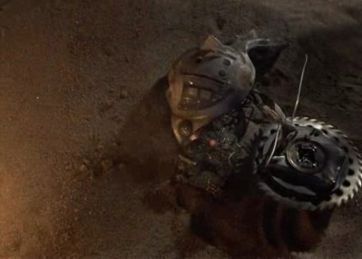Science Fiction
Dictionary
A B C D E F G H I J K L M N O P Q R S T U V W X Y Z
'Sandfish' Robot Moves Through Sand

A new sand-diving robot based on the sandfish lizard has been developed by a team led by Daniel I. Goldman, a physicist at Georgia Institute of Technology.
The sandfish lizard tucks in its limbs and wiggles forward with a whole-body sinusoidal traveling wave motion. Take a look at this video to see how the robot imitates the living organism.
(Sandfish robot video)
the team built a 35-centimetre-long version of the robot, made from seven aluminium segments linked by six motors, all clothed in spandex to prevent the motors from becoming jammed.The team then tested their robot by burying it in a container filled with plastic spheres 6 millimetres across. When the robot undulated its body at a frequency similar to the lizard, they found it could move forward at speeds of up to 0.3 body lengths per wave cycle - just below the 0.4 body lengths per cycle that a submerged lizard can achieve.
The intent is to create robots that can easily move through rubble to find and rescue people trapped in earthquakes or other catastrophes.
Science fiction writers (and readers) tend to find more sinister uses for robots that move easily through the earth and sand. For example, the claws from Philip K. Dick's 1953 story Second Variety are described burrowing upward from underground robotic factories - they "run and burrow."

(Claws - or Screamers - from the 1995 movie)
Consider also the robot earthworms from Harry Harrison's 1962 short story War With The Robots.
Read more about the sandfish lizard-based robot research and see the more recent New Scientist article.
Scroll down for more stories in the same category. (Story submitted 6/26/2010)
Follow this kind of news @Technovelgy.| Email | RSS | Blog It | Stumble | del.icio.us | Digg | Reddit |
Would
you like to contribute a story tip?
It's easy:
Get the URL of the story, and the related sf author, and add
it here.
Comment/Join discussion ( 0 )
Related News Stories - (" Robotics ")
Artificial Skin For Robots Is Coming Right Along
'... an elastic, tinted material that had all the feel and appearance of human flesh and epidermis.' - Harl Vincent (1934)
Robot Guard Dog On Duty
I might also be thinking of K-9 from Doctor Who.
Wearable Artificial Fabric Muscles
'It is remarkable that the long leverages of their machines are in most cases actuated by a sort of sham musculature...' HG Wells, 1898.
Dancing Robots Taught Dance Moves
'A clockwork figure would be the thing for you...' Jerome K. Jerome, 1893.
Technovelgy (that's tech-novel-gee!) is devoted to the creative science inventions and ideas of sf authors. Look for the Invention Category that interests you, the Glossary, the Invention Timeline, or see what's New.
Science Fiction
Timeline
1600-1899
1900-1939
1940's 1950's
1960's 1970's
1980's 1990's
2000's 2010's
Current News
Replace The Smartphone With A Connected Edge Node For AI Inference
'Buy a Little Dingbat... electropen, wrist watch, pocketphone, pocket radio, billfold ... all in one.'
Artificial Skin For Robots Is Coming Right Along
'... an elastic, tinted material that had all the feel and appearance of human flesh and epidermis.'
Robot Guard Dog On Duty
I might also be thinking of K-9 from Doctor Who.
Wearable Artificial Fabric Muscles
'It is remarkable that the long leverages of their machines are in most cases actuated by a sort of sham musculature...'
BrainBridge Concept Transplant Of Human Head Proposed
'Briquet’s head seemed to think that to find and attach a new body to her head was as easy as to fit and sew a new dress.'
Google's Nano Banana Pro Presents Handwritten Math Solutions
'...copy was turned out in a charming and entirely feminine handwriting.'
Edible Meat-Like Fungus Like Barbara Hambly's Slunch?
'It was almost unheard of for slunch to spread that fast...'
Sunday Robotics 'Memo' Bot Has Unique Training Glove
'He then started hand movements of definite pattern...'
Woman Marries Computer, Vonnegut's Dream Comes True
'Men are made of protoplasm... Lasts forever.'
Natural Gait With Prosthetic Connected To Nervous System
'The leg was to function, in a way, as a servo-mechanism operated by Larry’s brain...'
Spidery 'Walk Me' Toyota Autonomous Wheel Chair Like Star Wars
Walk along with the emperor.
Dancing Robots Taught Dance Moves
'A clockwork figure would be the thing for you...'
Proof Of Robothood - Not A Person
'Who are you people? - Show 'em.'
Indonesian Clans Battle
'The observation vehicle was of that peculiar variety used in conveying a large number of people across rough terrain.'
The 'Last Mile' In China Crowded With Delivery Robots
Yes, it's a delivery robot. On wheels.
Tornyol Microdrone Kills Mosquitoes
'The real border was defended by... a swarm of quasi-independent aerostats.'
